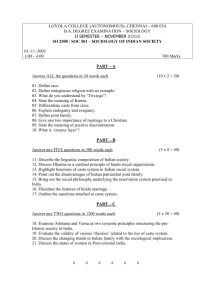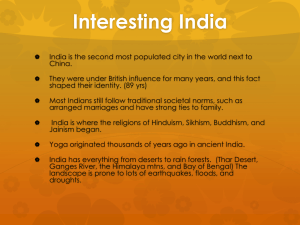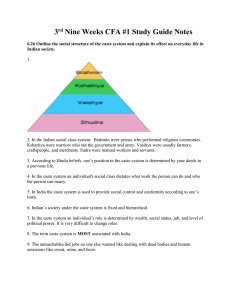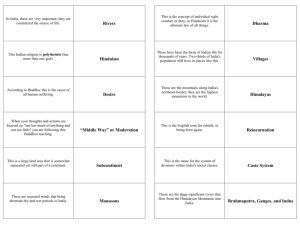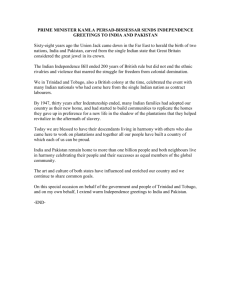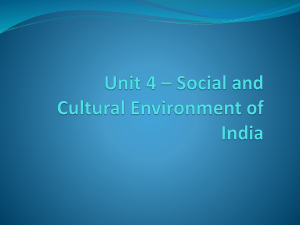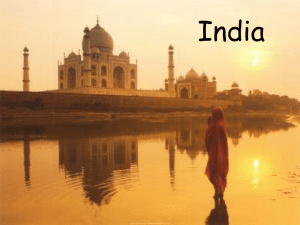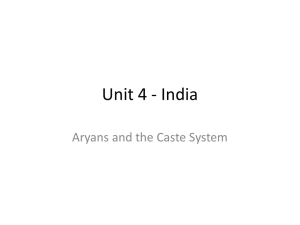Study Guide- South Asia Test Friday, April 11 th Terms & people to
advertisement
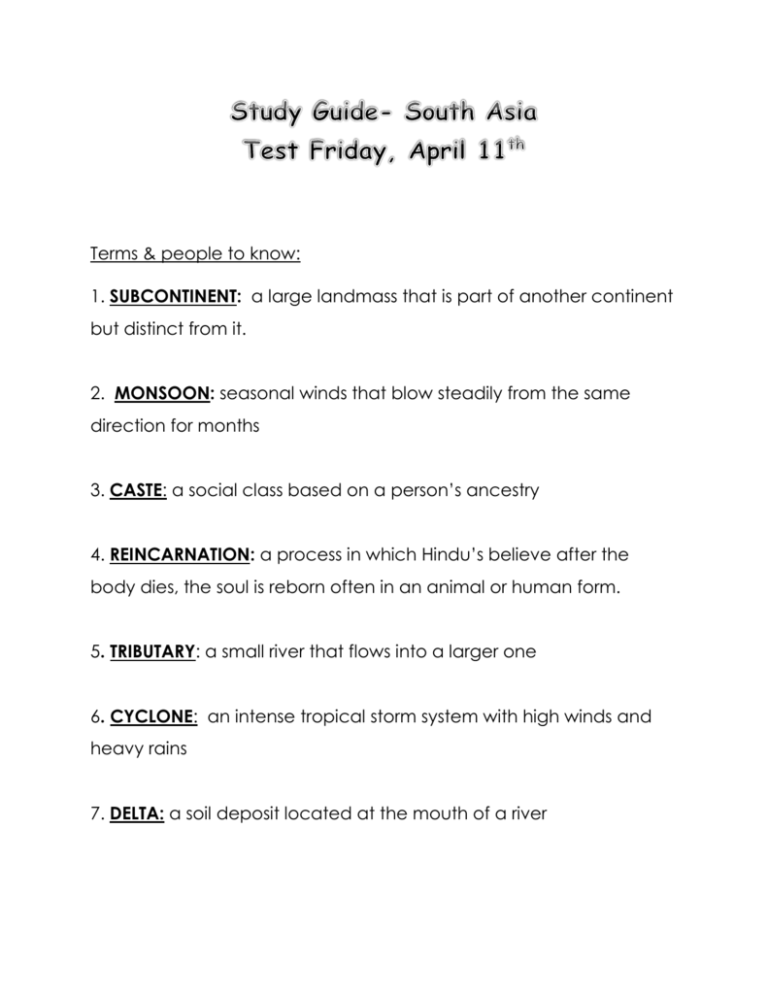
Terms & people to know: 1. SUBCONTINENT: a large landmass that is part of another continent but distinct from it. 2. MONSOON: seasonal winds that blow steadily from the same direction for months 3. CASTE: a social class based on a person’s ancestry 4. REINCARNATION: a process in which Hindu’s believe after the body dies, the soul is reborn often in an animal or human form. 5. TRIBUTARY: a small river that flows into a larger one 6. CYCLONE: an intense tropical storm system with high winds and heavy rains 7. DELTA: a soil deposit located at the mouth of a river 8. KHYBER PASS: a mountain range pass used by people traveling through South Asia from the north 9. DZONGS: Buddhist center for prayer 10. LAGOON: a shallow pool of water surrounded by reefs, sandbars or atolls 11. ATOLL: low lying ring shaped island that surrounds a lagoon 12. HINDUISM: the oldest religions of humanity; the religion of the Indian people 13. SLASH & BURN FARMING: a method of clearing land for planting by cutting and burning forests. 14. SIDDARTHA GAUTANMA: “Buddha” founder of Buddhism 15. MAHATMA GANDHI: he achieved Indian independence from Great Britain; he was born into a high caste family 16. Slums: poor and overcrowded area of living 17. Holi: the festival of color, usually celebrated in March.. a very wild festival with dancing, singing, and throwing of pain 18. Diwali: the festival of light- celebrated by the Hindus,Sikhs and Jains. It is also referred to as the “festival of lights” 19. Sari: a long cloth worn wrapped around and over the shoulder 20. Winter & Summer monsoons: -In the winter, the monsoon winds blow in a southwest directions bringing cool, dry air to India. - In the summer, monsoon winds blow in a northeast direction, picking up moisture from the Indian Ocean 21. Buddhism: was founded by Siddhartha Gautama – he was known as “Buddha” which means enlightened one. - The Buddha’s fundamental truths of life are: All men who are born eventually to have to die, sickness comes to all men, old age comes to all men, and renouncing worldly possessions is the way to live peacefully. 22. Hinduism- is one of the oldest religions of humanity; it is the religion of the Indian people. It focuses on tolerance and diversity. It came out of the early Indus Valley Civilization. It also comes from the Vedic writings and beliefs. The basic beliefs are: - There is no prophet - There is no one religious book - It was developed over many hundreds of years- no founder - Open to different beliefs 23. The Indian Caste System- its goal is to keep order and peace among the people- the levels are: 1. Braham (priests) their purpose it to help people of other castes fulfill their dharma 2. Kshatriya: they are responsible for leadership of the people 3. Vaishya: skilled traders, merchants and shopkeepers who sell products 4. Sudras: unskilled workers 24. Untouchables: they belong to no caste, expected to do the “dirty” jobs.. had to avoid contract with “caste” Indians for fear of “pollution” 25. Hindu Gods: - Brahma: creator of the world, has 4 heads - Vishnu: has kept the universe going for 432 million years, has 4 arms, very kindly nature, descends to earth whenever a catastrophe occurs - Shiva: Destroys the universe to begin the cycle again, drinks the sins of people, has a 3rd eye - Krishna: one of the most popular Gods, oversees love (of God and people), plays the flute 26. Civil disobedience: Using non-violet actions 27. British East India Company: a British company that basically ran India, it controlled the army, and they imported cotton cloth woven by Indian weavers 28. Sepoy: to go against a leader 29. Mahatma Gandhi: he developed a new non-violent way to make things right, by getting lots of people to disobey unfair laws, and to be uncooperative with rulers who were treating them badly. He was assassinated in 1948 30. Malala: a young Pakistain girl who was shot in the face because she went to school. 31. Taliban: a group of Islamist militants in Afghanistan and Pakistan 32. Ali Jinnah: believes Indians and Muslims cannot co-exist..Muslims and Hindus have different cultures 33. Jawaharlal Nehru: believed in combined different groups in one Nation 34. Reason for tension between Pakistan and India: - they are fitting over Kashmir which borders India & Pakistan. They both want control because of its vast water resources. *** Review what political cartoons are and how to analyze one ( use your India packet for review pg. 36) *** Know how to read a population pyramid- use your India packet for practice (pg. 40) Essay Question: Be able to analyze the political cartoon Mr. Grossman gave out

